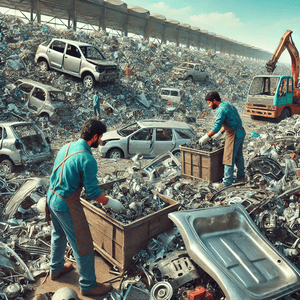Understanding Your Vehicle's Hidden Value
Many vehicle owners are surprised to learn about the significant value locked within their end-of-life vehicles (ELVs). What might appear as an old, non-functional car actually contains numerous valuable components and materials. Understanding this hidden value is crucial for making informed decisions about your vehicle's end-of-life management.
Precious Metals: The Hidden Treasure
Modern vehicles contain significant amounts of precious metals, particularly in catalytic converters. These essential emission control devices contain platinum, palladium, and rhodium - metals more valuable per gram than gold. A single catalytic converter can contain up to 2-7 grams of these precious metals, with current market values making them exceptionally valuable components.
The value of these metals has increased dramatically in recent years. For example, rhodium, which traded at around $640 per ounce in 2016, reached peaks of over $21,000 per ounce in 2021. This surge in value reflects both the increasing demand for these metals in new technologies and their critical role in environmental protection. Professional recycling ensures these valuable materials are properly recovered and returned to the manufacturing cycle.
Evolution of Automotive Materials
1970s-1980s Vehicles
Vehicles from this era represent a unique value proposition in the recycling industry. These classic models were built with significantly higher percentages of pure metals, making them particularly valuable in today's market. Their electrical systems, while simpler than modern vehicles, contain substantial amounts of pure copper wiring that can be easily extracted. The straightforward construction methods used in this era also mean that dismantling processes are more efficient, allowing for better preservation of valuable components.
1990s-2000s Vehicles
This transition period marked a significant shift in automotive design and material use. Manufacturers began incorporating more sophisticated electronics and higher-grade catalytic converters, responding to stricter emission standards. The increased use of aluminum in these vehicles, particularly in engine components and body panels, makes them especially valuable in today's recycling market where aluminum commands premium prices.
Modern Vehicles (2010 onwards)
Contemporary vehicles represent the pinnacle of automotive technology, packed with valuable materials and components. Their sophisticated electronic systems contain significant amounts of rare earth elements, while their emission control systems boast the highest concentrations of precious metals seen in automotive history. These vehicles also feature advanced composite materials that, while challenging to recycle, are driving innovation in recovery techniques.
Material Value Assessment
The process of extracting value from end-of-life vehicles requires understanding the complex mix of materials present in modern vehicles. Each component category represents unique opportunities for value recovery.

Ferrous Metals: The Foundation
Making up 65-70% of a vehicle's weight, ferrous metals form the structural backbone of every car. High-strength steel dominates the body panels and chassis, while cast iron is found in engine blocks and cylinder heads. The suspension system relies on specialized spring steel, and transmission cases employ various steel alloys. These materials, while common, represent a significant portion of a vehicle's recyclable value due to their sheer volume and the growing global demand for recycled steel.
Non-Ferrous Metals: Premium Materials
Non-ferrous metals, comprising 8-12% of vehicle weight, often represent higher value per kilogram than their ferrous counterparts. Aluminum components are increasingly common in modern vehicles, found in engine blocks, wheels, and body panels. Copper, essential for electrical systems and motors, has seen its value surge with the growth of electric vehicles and renewable energy systems. Zinc, lead, and magnesium play crucial roles in various components and command high recycling values.
Environmental Impact and Resource Conservation
Professional vehicle recycling creates substantial environmental benefits while recovering valuable materials. Each recycled vehicle contributes to significant resource conservation:
Resource Savings
The recycling of a single vehicle typically results in:
- arrow_forward Conservation of 2,500 kg of iron ore
- arrow_forward Preservation of 1,400 pounds of coal
- arrow_forward Saving of 120 pounds of limestone
Energy Conservation
The energy savings achieved through recycling are substantial:
- arrow_forward Aluminum recycling saves 95% of primary production energy
- arrow_forward Steel recycling reduces energy consumption by 60%
- arrow_forward Copper recycling preserves 85% of mining energy requirements
Professional Recycling Process
Modern vehicle recycling combines advanced technology with environmental responsibility to maximize value recovery while ensuring proper handling of hazardous materials.
Initial Assessment
Each vehicle undergoes comprehensive evaluation, including documentation verification, component inventory, and material composition analysis. This systematic approach ensures that each vehicle's unique value proposition is fully understood and can be maximized through appropriate processing methods.
Decontamination Process
The decontamination phase represents a critical juncture where environmental protection meets value recovery. Skilled technicians carefully drain and segregate various automotive fluids, remove batteries, and purge fuel systems. This meticulous approach prevents environmental contamination while preserving valuable materials for recycling.
The Future of Vehicle Recycling
The vehicle recycling industry continues to evolve with new technologies and challenges. Emerging technologies include AI-powered sorting systems, advanced chemical recycling processes, and automated dismantling systems. The industry faces new challenges with electric vehicle batteries, carbon fiber composites, and rare earth elements recovery.
These developments are driving innovation in recycling processes and creating new opportunities for value recovery. As vehicles become more complex, recycling technologies must adapt to handle new materials and components effectively while maintaining high recovery rates.
Professional Vehicle Assessment
With decades of experience in professional vehicle recycling, our certified facilities ensure you receive fair value for your vehicle while contributing to environmental sustainability. Our transparent processes and commitment to excellence have earned us recognition as a trusted partner in vehicle recycling.